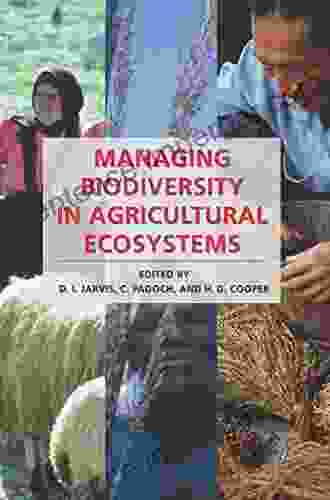Managing Biodiversity in Agricultural Ecosystems

A Comprehensive Guide to Sustainable Agriculture
In the face of climate change and increasing food insecurity, managing biodiversity in agricultural ecosystems has become more critical than ever before. Biodiversity, the variety of life on Earth, plays a crucial role in sustaining healthy and productive agricultural systems.
4.7 out of 5
| Language | : | English |
| File size | : | 4741 KB |
| Text-to-Speech | : | Enabled |
| Screen Reader | : | Supported |
| Enhanced typesetting | : | Enabled |
| Print length | : | 512 pages |
This comprehensive guide explores the benefits, challenges, and best practices for enhancing biodiversity in farming systems. By understanding the intricate relationships between plants, animals, and the environment, we can create resilient and sustainable agricultural ecosystems that benefit both nature and humanity.
Benefits of Biodiversity in Agricultural Ecosystems
- Increased crop productivity: Diverse plant communities increase soil fertility, reduce erosion, and attract pollinators, all of which contribute to higher crop yields.
- Improved pest and disease control: A variety of plant species and natural habitats provide shelter and food sources for beneficial insects and animals that prey on pests and diseases.
- Enhanced soil health: Diverse plant cover improves soil structure, increases organic matter, and promotes water infiltration, leading to healthier soil.
- Conservation of genetic resources: Agricultural biodiversity is a valuable reservoir of genetic diversity, which is essential for developing new crop varieties and adapting to future challenges.
li>Climate change resilience: Diverse agricultural ecosystems are more resilient to extreme weather events, such as floods, droughts, and heat waves.
Challenges to Managing Biodiversity
- Habitat loss and fragmentation: Agricultural intensification and urban development have led to the loss and fragmentation of natural habitats, reducing biodiversity.
- Pesticide and fertilizer use: Excessive use of pesticides and fertilizers can harm beneficial insects and organisms, reducing biodiversity.
- Climate change: Rising temperatures, changes in precipitation patterns, and extreme events can impact plant and animal populations, affecting biodiversity.
- Invasive species: Invasive species can compete with native species for resources, reducing biodiversity.
- Market demands: Agricultural markets often favor monocultures, which reduce biodiversity.
Best Practices for Enhancing Biodiversity
- Diversify crop rotations: Planting a variety of crops in sequence helps maintain soil health, reduce pest and disease pressure, and attract beneficial insects.
- Incorporate cover crops: Planting non-harvested crops during the off-season provides habitat for wildlife, improves soil health, and reduces erosion.
- Establish field margins and buffer zones: Leaving uncultivated areas around fields provides habitat for natural enemies of pests and pollinators.
- Reduce pesticide and fertilizer use: Use integrated pest management (IPM) techniques and organic fertilizers to minimize the impact on beneficial organisms.
- Promote agroforestry: Integrating trees and shrubs into agricultural systems provides habitat for wildlife, improves soil health, and sequesters carbon.
- Support local and organic farming: Consumers can support biodiversity by purchasing food from farmers who prioritize sustainable practices.
Managing biodiversity in agricultural ecosystems is essential for the sustainability of our food systems and the well-being of our planet. By implementing best practices and addressing the challenges, we can create diverse and resilient agricultural ecosystems that provide a wide range of benefits.
This comprehensive guide provides a wealth of information and insights to help farmers, policymakers, and consumers understand the importance of biodiversity in agriculture and take action to protect and enhance it. By embracing biodiversity, we can ensure a sustainable and food-secure future for generations to come.
4.7 out of 5
| Language | : | English |
| File size | : | 4741 KB |
| Text-to-Speech | : | Enabled |
| Screen Reader | : | Supported |
| Enhanced typesetting | : | Enabled |
| Print length | : | 512 pages |
Do you want to contribute by writing guest posts on this blog?
Please contact us and send us a resume of previous articles that you have written.
 Book
Book Novel
Novel Page
Page Chapter
Chapter Text
Text Story
Story Genre
Genre Reader
Reader Library
Library Paperback
Paperback E-book
E-book Magazine
Magazine Newspaper
Newspaper Paragraph
Paragraph Sentence
Sentence Bookmark
Bookmark Shelf
Shelf Glossary
Glossary Bibliography
Bibliography Foreword
Foreword Preface
Preface Synopsis
Synopsis Annotation
Annotation Footnote
Footnote Manuscript
Manuscript Scroll
Scroll Codex
Codex Tome
Tome Bestseller
Bestseller Classics
Classics Library card
Library card Narrative
Narrative Biography
Biography Autobiography
Autobiography Memoir
Memoir Reference
Reference Encyclopedia
Encyclopedia Jeff A Menges
Jeff A Menges Janay Brun
Janay Brun Jeanne Martinet
Jeanne Martinet James Mcfarland
James Mcfarland James Hillman
James Hillman James Jacques
James Jacques James Raffan
James Raffan James Kotsiras
James Kotsiras Jeff Jacobson
Jeff Jacobson James Young
James Young Jason Dyer
Jason Dyer Jean Boiffin
Jean Boiffin James Wong
James Wong Janina Fisher
Janina Fisher Janine Turner
Janine Turner Jay Gurden
Jay Gurden Jason Drew
Jason Drew James E Brumbaugh
James E Brumbaugh Jane Mcgregor
Jane Mcgregor James Rankin
James Rankin
Light bulbAdvertise smarter! Our strategic ad space ensures maximum exposure. Reserve your spot today!

 Italo CalvinoChinese Calligraphy Arts Running Hand Vol 143: A Journey into the Flowing...
Italo CalvinoChinese Calligraphy Arts Running Hand Vol 143: A Journey into the Flowing... Kirk HayesFollow ·17.7k
Kirk HayesFollow ·17.7k Eric NelsonFollow ·18.1k
Eric NelsonFollow ·18.1k Will WardFollow ·18.2k
Will WardFollow ·18.2k Andrew BellFollow ·10.9k
Andrew BellFollow ·10.9k Cooper BellFollow ·14.2k
Cooper BellFollow ·14.2k Terry BellFollow ·9.3k
Terry BellFollow ·9.3k Carl WalkerFollow ·19.2k
Carl WalkerFollow ·19.2k Greg FosterFollow ·16.6k
Greg FosterFollow ·16.6k

 Jacob Foster
Jacob FosterPrinciples and Persons: The Legacy of Derek Parfit
Derek Parfit's 1984 book,...

 Leo Mitchell
Leo MitchellPartners For Life: Raise Support For Your Missionary Work...
Are you a missionary or ministry leader...

 Blake Kennedy
Blake KennedyOn Desperate Ground: A Gripping Account of World War II's...
Hampton Sides' "On...

 Duane Kelly
Duane KellyCriminal Minds Sociopaths Serial Killers And Other...
In the realm of criminology,...

 Craig Blair
Craig BlairHome Repair: The Ultimate Guide to Fix, Maintain, and...
Welcome to the...

 Elmer Powell
Elmer PowellThe Organic Grower Guide to Mycorrhizae Science for...
Unlock the Secrets of Soil...
4.7 out of 5
| Language | : | English |
| File size | : | 4741 KB |
| Text-to-Speech | : | Enabled |
| Screen Reader | : | Supported |
| Enhanced typesetting | : | Enabled |
| Print length | : | 512 pages |










